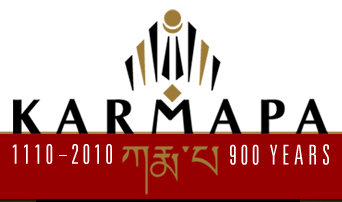Dusum Khyenpa was born in the year 1110 CE, in Dreshö, a part of Dreho, Kham, ringed by snow-covered mountains. His family was a humble one, with greater aptitude for spiritual practice than worldly success. Both his parents were active practitioners, and exposed the young Dusum Khyenpa to Dharma instruction and practice from an early age.
During his teenage years, Dusum Khyenpa was plunged into great inner turmoil when he lost the woman he loved to another man. After he had weathered this emotional storm, with a stable certainty born of his recognition of the suffering caused by his own afflictive emotions, Dusum Khyenpa left behind the householders’ life once and for all at the age of sixteen. He was ordained as a novice monk by Dreho Chogi Lama, a 70-year old disciple of the great Tibetan translator Ngok Lotsawa. Upon receiving his monastic vows, Dusum Khyenpa had a vision that the Buddha presented him with a black hat. He later fashioned a physical hat modelled on the one in his vision, and this became the first material hat associated with the Karmapa line. At this time, he was given his epithet “Karmapa,” or “Being of Enlightened Activity,” as a secret name. Since that time, with just one exception—the Fifteenth Karmapa—every Karmapa in the 900-year history of the lineage has lived their life as a Buddhist monk, engaging in their enlightened activities to benefit others on the basic of monastic vows.
Within three years of his ordination, Dusum Khyenpa was on his way to central Tibet, to the preeminent sites for rigorous scholarly study as well as meditative practice. There, Dusum Khyenpa read the most challenging Indian treatises with the finest teachers of the day. With no less illustrious scholars than the brilliant Chapa Chökyi Senge and his teacher Gyamarpa, Dusum Khyenpa studied the principal texts of Asanga, as well as Nāgārjuna’s Mūlamadhyamakakārikās, Candrakīrti’s Madhyamakāvatāra and Āryadeva’s Catuhśataka, gaining a clear understanding of the views of the two major streams of Mahāyāna Buddhist philosophy—Cittamātra and Madhyamaka. Next, as a particularly promising student, he was taught the six treatises of Nāgārjuna by Patsab Lotsāwa, the century’s greatest proponent of Prāsangika Madhyamaka philosophy. For a further six years, Dusum Khyenpa studied Kadampa texts under the Kadam master, Geshe Sharwapa, and received additional tantric training.
When he reached the age of 30, Dusum Khyenpa left in search of the lama whose lineage he would later transmit: Lord Gampopa, then residing in his own seat at Daklha Gampo. From the outset, Dusum Khyenpa followed Gampopa’s advice with tremendous diligence and respect. Over the years, Gampopa guided Dusum Khyenpa with great skill, again and again offering him instruction for some time and then sending this determined meditator off to practice in solitude.
After training and meditating for several years in this way, Dusum Khyenpa went to see Gampopa to relate his experience and seek further instruction. After listening to Dusum Khyenpa’s descriptions of his meditative experiences, Gampopa responded: “I had great hopes in you before, but this is disappointing. You have to keep meditating.” Following Gampopa’s advice, Dusum Khyenpa meditated for another six months, but saw no change in his meditation. Nevertheless, he gained firm conviction in his own experience, despite Gampopa’s assertion of doubt. Dusum Khyenpa stated, “There’s no way this is wrong. Even if it is wrong, this is how I’m going to meditate.” In this way, Gampopa guided Dusum Khyenpa to the point of unshakable certainty in his own meditative experiences. This time, when Dusum Khyenpa returned to report once again on his meditation, the great Gampopa placed his hand upon Dusum Khyenpa’s head and told him, “Son, you have already severed the bonds to samsara.”
Although Gampopa was guiding vast numbers of students at this point, Dusum Khyenpa’s tremendous devotion to Gampopa lent a distinct flavor to their lama-disciple relationship. During one of the periods Dusum Khyenpa was staying at Daklha Gampo, Gampopa distributed cloth to his three close disciples from Kham—Seltong Shogom, Phagmodrupa and Dusum Khyenpa, known among Gampopa’s disciples as the Three Men from Kham. Gampopa instructed each of them to make a hat from the material. Dusum Khyenpa valued so highly the cloth he received from his lama that he painstakingly fashioned it into the most beautiful shape he could. Some time later, Gampopa called the three disciples and asked them to bring the hats they had made. Seltong Shogom had neglected to attend to the task, and when the summons came, he hastily attempted to craft the material into a hat-like shape. Dusum Khyenpa, meanwhile, arrived with the resplendent hat he had taken such care to construct.
Dusum Khyenpa’s exertions with the fabric reveal a great deal about his character. His care in transforming what Gampopa had given him into a glorious crown was interpreted as an auspicious sign for the future of the lineage he had received from Gampopa—the lineage known today as the Karma Kagyu. Indeed, Dusum Khyenpa’s efforts to preserve and value what Gampopa had given him have yielded beautiful and long-lasting results.
In 1153, 14 years after Dusum Khyenpa met Gampopa, the lama who had cared for him so kindly passed away. Dusum Khyenpa learned of the loss when he met Gampopa’s nephew Gomtsul and a second disciple named Phagpa in Ölkha. Clutching a garment that had belonged to Gampopa, Dusum Khyenpa made supplications and wept. As he did so, a vision of Gampopa appeared in the sky, clearly visible to all three of them (see photo). The astonishing apparition did much to assuage Dusum Khyenpa’s pain, and he commented, “The lama came to dispel my grief.”
Every year thereafter, Dusum Khyenpa marked the anniversary of Gampopa’s death, and later established the practice of doing so in the monasteries he himself founded. Dusum Khyenpa retained a deep gratitude and a sense of commitment not only to Gampopa himself but also to the seat he had created at Daklha Gampo. Throughout his life, when Dusum Khyenpa received large offerings, he often sent them to Daklha Gampo to support the community and facilities that Gampopa had founded.
Recalling advice he had received earlier from Gampopa, Dusum Khyenpa later returned to his native land of Kham, where he swiftly began to attract disciples. Before long, the number of monks in his community exceeded 1,000. In 1164, on a spot tucked among gentle peaks, Dusum Khyenpa founded the first of his three major seats—Kampo Nenang Monastery. On this site, Dusum Khyenpa established a retreat centre and monastery, and devoted the next two decades of his life to cultivating realization in the many students who came seeking his guidance. Among those disciples was Drogön Rechen, Dusum Khyenpa’s heart disciple. Along with transmitting Dusum Khyenpa’s lineage, Drogön Rechen became instrumental in recognizing that the Second Karmapa, Karma Pakshi, was, in fact, the reincarnation of Dusum Khyenpa. It was to Drogön Rechen that Dusum Khyenpa gave the letter granting details of his next incarnation.
Along with fulfilling his life’s purpose of caring for his students, Dusum Khyenpa was active in dispelling disputes, mediating between feuding factions across Kham. His skilful intervention, and in some cases his mere presence, repeatedly resulted in the resolution of deeply entrenched animosities and personal conflicts. This pattern of peacemaking recurs again and again in the lives of Dusum Khyenpa’s successors in the Karmapa reincarnation line, and forms a key component of their activity in the world.
When he was 74 years old, Dusum Khyenpa founded his second major seat, Karma Gön monastery. Thereafter, in his late 70s, an age when most would consider their life’s work done or nearly so, Dusum Khyenpa determined to travel clear across Tibet to central Tibet, where he would fulfill advice he had received from Lama Gomtsul, the nephew of Gampopa and complete several other projects with far-reaching effects.
For one, Dusum Khyenpa’s powers to pacify dispute were urgently needed in central Tibet, for a fellow disciple of Gampopa named Lama Zhang was exhibiting increasingly assertive behavior that was incurring considerable social disapproval. Although many others had attempted to convince Lama Zhang to renounce his activities, none had met with success. However, during a meeting with Dusum Khyenpa, the highly unconventional Lama Zhang is said to have danced wildly about the room, tugged on one of Dusum Khyenpa’s fingers, and then immediately renounced his controversial behavior once and for all. Through his activities in negotiating with Lama Zhang, Dusum Khyenpa made an important contribution to peace in central Tibet.
Another major deed of Dusum Khyenpa during this period was the founding of Tsurphu Monastery, west of Lhasa. Tsurphu would go on to become a thriving centre for study and practice, and an important site for the continuity of the Karmapa reincarnation line. For 900 years, in every single successive lifetime, the Karmapa has resided for some period at Tsurphu Monastery.
With the far-ranging deeds of his life thus complete, in 1193, Dusum Khyenpa entrusted his books and relics to his main student, Drogön Rechen, to whom he had already handed the prediction letter regarding his next reincarnation. He gave away the remainder of his possessions to various Dharma communities in Gampopa’s lineage. On the third day of the Tibetan New Year, Dusum Khyenpa gave a final Dharma teaching to the assembly at Tsurphu, lifted his gaze to the sky and entered meditation. He sat thus meditating for the remainder of the morning. At noon, the First Karmapa relinquished the body he had used to benefit beings in that lifetime, and moved on to take the next, as Karma Pakshi, the Second Karmapa.
In this way, although his activities of that life were complete, the Karmapa’s vast deeds to work for the welfare of the world were only beginning. The impetus of his determination and unbearable compassion have made the Karmapa lineage he founded the longest reincarnation in history. Today, a full 900 years later, the Karmapa continues that work in the form of the Seventeenth Gyalwang Karmapa, Ogyen Trinley Dorje—carrying Dusum Khyenpa’s compassion and commitment into a new century and addressing the new problems of the world with Dusum Khyenpa’s determination and skilful means.
|
|
|||
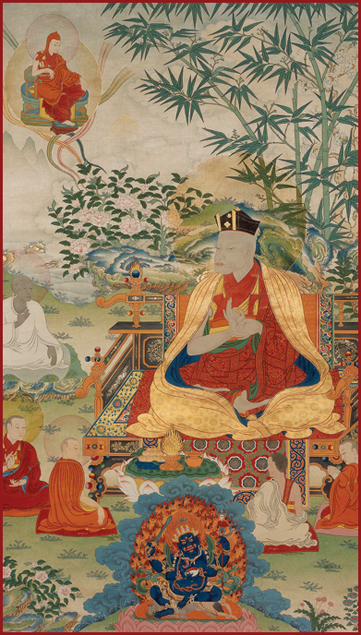 Dunsum Khyenpa 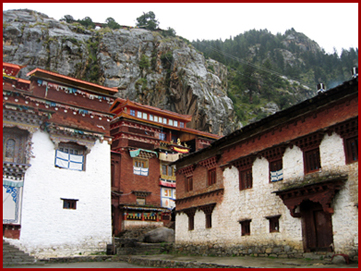 Pangpuk, another monastery founded by Dusum Khyenpa. Photo credit: Rokpa 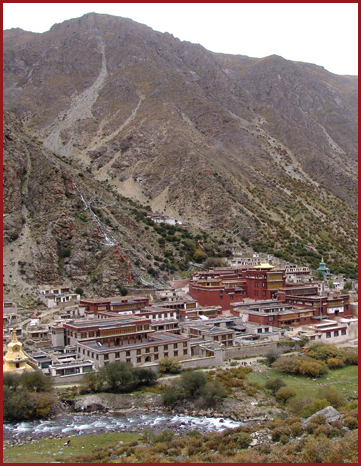 Tsurphu Monastery in Tibet. Photo by Karma Jinpa 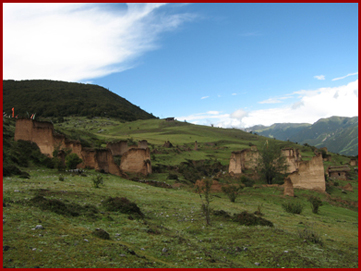 Hilltop in eastern Tibet where Dusum Khyenpa was thought to have written the prediction letter that he entrusted to his chief disciple, Drogön Rechen. Photo credit: Rokpa |
DUSUM KHYENPA |
||
